10 Must-Know Tips for a Stress-Free Move
Relocating to a new home marks the beginning of an exciting chapter in life, teeming with the promise of new memories and experiences. Yet, the journey to settle into your new space, especially in areas as bustling as Middlesex County, can sometimes feel intimidating. The key to transforming a potentially overwhelming move into a smooth and enjoyable adventure lies in the power of preparation. With strategic planning and organization, you can navigate this transition with minimal stress, making your move not just manageable, but also an opportunity for a fresh and organized start. Here are the initial steps to ensure your move is as stress-free as possible, paving the way for a seamless transition to your new home.
- Start Planning Early
Starting the planning process weeks, or ideally months, ahead of your move can significantly ease the pressure that comes with relocating. Early planning allows you the luxury of time to research and hire movers, sort through your belongings, and begin packing non-essential items without the stress of a looming deadline. This proactive approach helps in avoiding last-minute hiccups and ensures a more organized and controlled moving experience.
- Choose Reliable Movers
The significance of entrusting your belongings to reputable and experienced movers cannot be overstated. For those residing in Middlesex County, New Jersey, selecting Middlesex County movers with a solid track record can alleviate much of the stress associated with moving day. Reliable movers not only ensure the safe transport of your possessions but also offer invaluable peace of mind, allowing you to focus on other aspects of your move. It’s worth investing time in researching and selecting a moving company that is well-reviewed, offers the specific services you need, and communicates transparently about their process and pricing.
- Declutter Your Space
A move presents the perfect opportunity to reevaluate your possessions and decide what truly adds value to your life. Decluttering before packing can dramatically reduce the volume of items you need to transport, saving on moving costs and the time required to unpack and organize your new home. Employ a critical eye towards each item, considering its utility, emotional value, and whether it fits with your envisioned lifestyle in your new space. Items that no longer serve a purpose can be sold, donated, or recycled, making your move a chance to lighten your load and start afresh.
- Pack an Essentials Box
The first few days in your new home can feel disorienting as you navigate through boxes and unpack your life. Packing an essentials box—or suitcase—can be a game-changer. This box should contain items you’ll need for the first night and following few days, such as toiletries, medications, a change of clothes, basic kitchen items, important documents, and chargers. Having these necessities easily accessible will allow you to maintain a semblance of normalcy as you settle in, without the need to dig through multiple boxes on your first night.
- Keep Important Documents Handy
In the whirlwind of moving, it’s crucial to keep your important documents organized and within easy reach. Create a dedicated folder for contracts, personal identification documents, moving company paperwork, and any other critical paperwork. This ensures that you have all necessary documents on hand for reference or action, whether it’s verifying the moving checklist with your movers or setting up services for your new home.
- Notify Services and Utilities
One of the most critical steps in ensuring a seamless transition involves your utilities and services. Contact your utility providers—electricity, water, gas, internet—at least two weeks before your move to schedule disconnection at your current home and set up at your new one. Similarly, update your address with banks, subscription services, and any other relevant institutions to ensure continuity of service and avoid missing important communications.
- Take Measurements
Nothing is more frustrating than arriving at your new home only to discover that your furniture doesn’t fit through the door or in the intended space. Before moving, measure the dimensions of your larger items and the spaces they’re meant to occupy in your new home. This preemptive step can save you time, effort, and the stress of last-minute rearrangements or the need to dispose of furniture that simply won’t fit.
- Prepare Your New Home
If you have the opportunity, preparing your new home before moving day can significantly reduce stress. This might include deep cleaning, painting, or making minor repairs. Ensuring that your new space is ready for occupancy makes the physical move easier and also helps you feel more comfortable and at home from the moment you arrive.
- Enlist Help
Moving is a substantial undertaking, and there’s no shame in enlisting help. Whether it’s friends and family pitching in on moving day or hiring professional packers to assist with the heavy lifting, having support can alleviate much of the physical and emotional strain. If you opt for professional help, coordinate with your movers in advance to discuss any specific requirements or concerns you may have.
- Take Care of Yourself
In the whirlwind of moving activities, it’s easy to neglect your well-being. However, maintaining your physical and mental health is vital. Ensure you’re eating nutritious meals, staying hydrated, and getting enough rest. Stress and fatigue can cloud your judgment and dampen the excitement of moving to a new home, so take moments to breathe and relax whenever possible.
Conclusion
Moving is more than just a physical transition; it’s the start of a new chapter in your life. By following these tips, including the crucial step of choosing the right movers, you’re setting the stage for a stress-free move. Each of these strategies—from notifying services and utilities to taking measurements, enlisting help, and taking care of yourself—plays a pivotal role in smoothing the transition.
The ultimate goal of your move is not just to transport belongings from one place to another but to create a space where new memories will be made, personal growth will occur, and life’s next adventures will unfold. With careful planning, organization, and a focus on well-being, you can ensure that your move is not only stress-free but also an enjoyable and rewarding experience.
Best Time to Visit Iceland: A Guide to the Seasons
Iceland is known for its breathtaking landscapes, unique culture, and the chance to witness the Northern Lights. However, with its unpredictable weather, visitors often wonder when the best time to visit Iceland is. The answer to this question largely depends on what travelers hope to experience during their trip.
For those who want to witness the Northern Lights, the best time to visit Iceland is from September to mid-April. During these months, the nights are longer, providing more opportunities to see the aurora borealis. However, visitors should be prepared for cold temperatures and the possibility of snow. On the other hand, those who want to experience Iceland’s warmer weather and longer days should plan their trip between May and August. This is also the best time for outdoor activities such as hiking and camping.
Booking a campervan adds ease to your plans to fully enjoy the outdoors in Iceland and get to your desired destinations. The van should make for a cozy, functional home at the end of each day and anytime the weather changes. Campers are also equipped for winter travel and related activities, such as chasing the northern lights. Indeed campervanning is a popular activity in Iceland, so you have plenty of options for a rental van in Iceland.
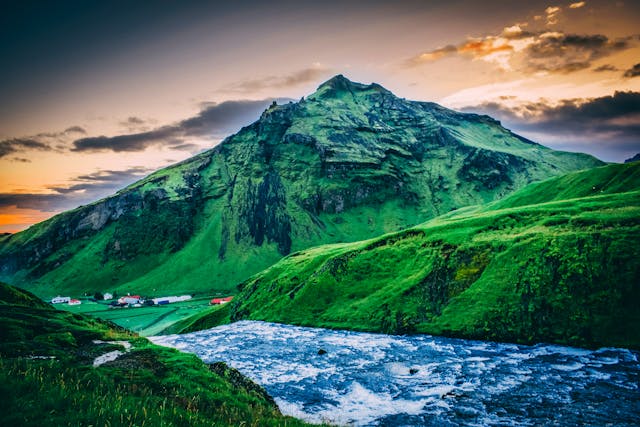
Understanding Iceland’s Seasons
Iceland’s location near the Arctic Circle means it experiences unique seasonal changes that can significantly impact your travel experience. Understanding the country’s seasons is crucial in planning a trip that suits your preferences and interests.
Summer: Advantages and Disadvantages
Summer in Iceland spans from June to August and is the peak tourist season. The weather is mild, and temperatures can range from 10°C to 15°C. The days are long, with almost 24 hours of daylight in June, and the midnight sun is a unique experience that attracts many visitors.
Summer is the best time to spot puffins and whales, as they migrate to Iceland’s shores during this season. However, the high tourist influx can make popular attractions crowded, and prices for accommodation and activities can be higher than usual.
Winter: Northern Lights and Snowscapes
Winter in Iceland is from December to February, and it’s the best time to witness the aurora borealis, also known as the Northern Lights. The snow-covered landscapes and frozen waterfalls create a winter wonderland that’s perfect for outdoor activities like snowmobiling, skiing, and ice caving.
The temperatures can drop to as low as -10°C, but the country’s geothermal spas and hot springs provide a warm and relaxing experience. However, daylight hours are limited, with only a few hours of sunlight each day.
Spring and Fall: Shoulder Seasons
Spring and Fall are the shoulder seasons in Iceland and offer a balance between the summer and winter experiences. The weather is mild, with temperatures ranging from 5°C to 10°C, and the crowds are thinner than in the peak season.
In Spring, the snow begins to melt, and the waterfalls are at their fullest, creating a spectacular sight. Fall brings colorful foliage, and the Northern Lights become visible again. However, the weather can be unpredictable, and some popular attractions may be closed.
Understanding Iceland’s seasons can help you plan your trip according to your preferences and interests. Whether you want to witness the midnight sun, Northern Lights, or enjoy outdoor activities, Iceland has something to offer in every season.
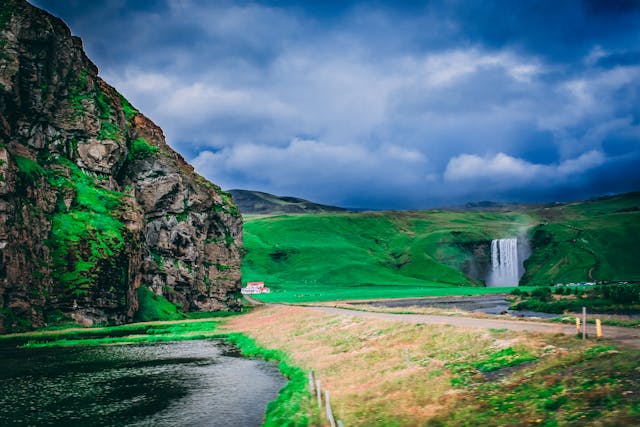
Monthly Breakdown for Visiting Iceland
January: The Heart of Winter
January is the coldest month in Iceland, with temperatures ranging from -1°C to 4°C. However, it is also the best time to see the Northern Lights, as the long nights and clear skies provide ideal conditions. The Winter Lights Festival in Reykjavik is also worth visiting, with illuminations and events throughout the city.
February: Winter Activities Peak
February is the peak of winter activities in Iceland, with ice caves and winter sports being the highlights. The weather is still cold, but the days are getting longer, providing more daylight for exploration.
March: Transitioning Seasons
March marks the transition from winter to spring, with snow still prevalent but temperatures starting to rise. The weather can be unpredictable, but it is a good time for hiking and seeing the snow-covered landscapes.
April: Spring’s Arrival
April is the month when spring arrives in Iceland, with temperatures ranging from 0°C to 7°C. Puffins start to return to the country, making it a great time for birdwatching. Hiking is also popular, with longer daylight hours and milder weather.
May: Mild Weather and Wildlife
May is a great time to visit Iceland, with mild weather and a chance to see whales and puffins. The crowds are still relatively low, and prices are starting to increase as the tourist season approaches.
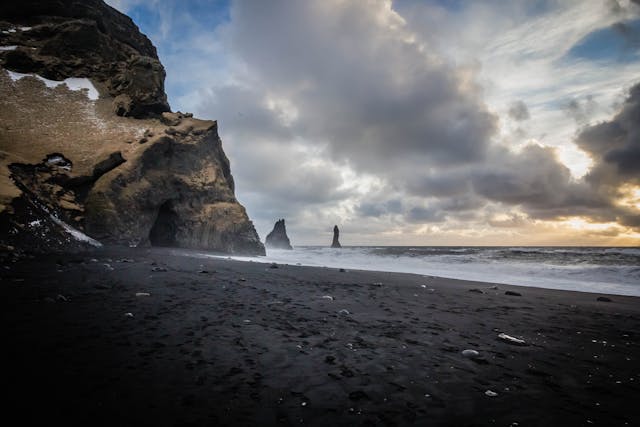
June: Start of the High Season
June marks the start of the high season in Iceland, with the first day of summer celebrated on the 20th. The midnight sun is also visible, providing 24 hours of daylight in some parts of the country. Festivals and events are also held throughout the month.
July: Full Swing of Summer
July is the peak of summer in Iceland, with warm temperatures and long days. Tourists flock to the country, making it the busiest time of the year. Nature is at its finest, with hiking, wildlife watching, and outdoor activities being popular.
August: Cultural Festivals and Warmth
August is a great time to experience Icelandic culture, with festivals and events held throughout the country. The weather is still warm, and Reykjavik is bustling with activity.
September: Beginning of the Shoulder Season
September marks the beginning of the shoulder season, with fewer tourists and lower prices. The Northern Lights start to become visible again, and fall colors start to appear. The weather can be unpredictable, but it is a good time for hiking and outdoor activities.
October: Fall Colors and Lower Prices
October is a great time to see the fall colors in Iceland, with temperatures ranging from 0°C to 6°C. Prices are also lower, and the crowds are smaller. The Northern Lights are also visible, making it a great time for aurora hunting.
November: Quieter Times and Early Winter
November is a quieter time in Iceland, with the start of winter and fewer tourists. The weather is cold, but the Northern Lights are visible, making it a great time for aurora hunting. Outdoor activities are still possible, but with shorter daylight hours.
December: Christmas Festivities and Polar Nights
December is a festive time in Iceland, with Christmas celebrations throughout the country. The weather is cold, and the days are short, with some parts of the country experiencing polar nights. The Northern Lights are also visible, making it a great time for aurora hunting.
I hope this helps you figure out the best time to visit Iceland for your travel goals. No matter what time of year you visit, I’m sure you’ll fall in love with this magical country and all it has to offer.
Stag Do In Prague: The Ultimate Guide to Planning a Memorable Bachelor Party in the Czech Capital
Prague, the capital city of the Czech Republic, has become a popular destination for stag do parties. Its vibrant nightlife, affordable prices, and wide range of activities make it an ideal location for a memorable bachelor party. With so much to offer, it’s no wonder that Prague has become one of the top stag do destinations in Europe.
A Prague stag do can include a variety of activities, from bar crawls and brewery tours to outdoor adventures like white water rafting and bobsledding. The city also boasts a thriving club scene, with plenty of options for partying into the early hours of the morning. For those looking for a more relaxed experience, Prague’s historic architecture, cultural landmarks, and delicious cuisine provide ample opportunities for sightseeing and indulging in local delicacies.
To make the most of a Prague stag do, it’s important to plan ahead. A guide or tour company can help with arranging activities, transportation, and accommodations. They can also provide insider knowledge on the best places to eat, drink, and party in the city. With a little bit of preparation, a Prague stag do can be an unforgettable experience for the groom-to-be and his friends.

Planning Your Stag Do in Prague
If you’re looking for a destination that offers a vibrant nightlife, plenty of activities and a lively atmosphere, Prague is an excellent choice for a stag do. With its beautiful architecture, rich history and affordable prices, it’s no wonder that more and more groups are choosing to celebrate their last night of freedom in the Czech Republic’s capital city.
Selecting the Right Accommodation
One of the first things to consider when planning your stag do in Prague is where you’ll be staying. There are plenty of options to choose from, ranging from budget-friendly hostels to luxurious hotels. It’s important to consider factors such as location, price and group size when making your decision.
Organizing Transfers and Navigation
Getting around Prague can be a bit tricky, especially if you’re not familiar with the city. To make things easier, it’s a good idea to organize transfers from the airport to your accommodation. You can also arrange for private transportation to take you and your group to various activities and nightlife hotspots throughout your stay.
Goldfingers Prague
If you’re looking for a stag do Prague activity that’s sure to impress, look no further than Goldfingers Prague. This popular club offers a range of packages that include VIP entry, drinks, and private shows. It’s the perfect way to kick off your night of partying in style.
Planning a stag do in Prague can be a lot of fun. With the right accommodation, transportation, and activities, you and your group are sure to have a memorable experience in this vibrant European city.
Activities and Entertainment
Prague is the perfect destination for a stag do, with a wide range of activities and entertainment to suit all tastes. Here are some of the top options for daytime adventures, nightlife and party venues, and cultural experiences.
Daytime Adventures
For adrenaline junkies, Prague offers a range of thrilling activities such as shooting ranges, go-karting, and white water rafting. Paintball and bubble football are also popular choices for stag groups looking for a bit of friendly competition.
If you’re looking for something more laid-back, why not explore the city’s stunning architecture and sights? The Old Town, Prague Castle, and Charles Bridge are all must-see attractions. Alternatively, hop on a beer cycle boat and take in the city as the sun sets.
Nightlife and Party Venues
Prague is renowned for its nightlife, with plenty of bars, pubs, and clubs to choose from. The city’s bar crawl is a great way to explore some of the best locations and meet fellow stag groups.
For a wild stag night, head to one of the city’s strip clubs or visit the red light district. Karlovy Lazne is the largest club in central Europe and offers five floors of music and entertainment. Goldfingers is another popular choice for those looking for x-rated fun.
Cultural Experiences
Prague is also home to a rich cultural heritage, with plenty of museums and galleries to explore. The Lennon Wall is a must-see for music fans, while the Astronomical Clock is a stunning example of medieval engineering.
For a taste of traditional Czech cuisine, head to one of the city’s many restaurants and try dishes such as goulash and dumplings. A Czech meal is the perfect way to soak up the local culture.
Overall, Prague offers a flexible and great range of activities and entertainment for stag groups. Whether you’re looking for outdoor paintball, dwarf hire, or steak & strip, Prague has it all. With a range of hotels and aparthotels such as Aparthotel Melantrich, Hotel Crystal Palace, Pension Prague City Hotel, Metropolitan Old Town Hotel, Hotel Charles Central, and Wenceslas Square Hotel, there’s something to suit every budget and taste.
Sustainable Travel: Leaving Light Footprints in Far-Flung Places
Sustainable travel has become increasingly significant as more people seek to explore the world without harming it. The drive towards sustainability is not just about preserving picturesque landscapes for future generations; it’s about ensuring that local communities thrive, and that the natural world remains vibrant and diverse. Travelers today are more conscious of their impact on the planet, prompting a shift towards more responsible tourism practices. This article delves into the various facets of sustainable travel, from understanding one’s environmental footprint to selecting destinations and practices that align with the ethos of minimal harm and maximum enjoyment.
Understanding Your Environmental Footprint
Your environmental footprint measures the impact your travel has on the planet. It encompasses everything from the carbon emissions of your flights to the waste generated by your consumption habits while on the road. Recognising the size of your footprint is the first step towards reducing it. It involves making informed choices about how and where you travel. For instance, a direct flight produces fewer emissions than multiple connecting flights, and staying in eco-friendly accommodations can significantly reduce your waste output. By calculating your footprint, you can start adjusting your travel plans that lessen your environmental impact.
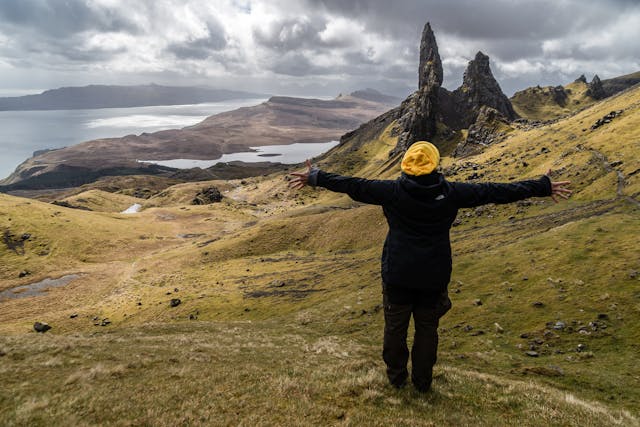
Choosing Eco-Friendly Destinations
Selecting destinations that are committed to sustainability is crucial in minimising your travel impact. Eco-friendly destinations often have measures in place to protect local ecosystems, wildlife, and culture while promoting responsible tourism practices. These places invest in sustainable infrastructure, from renewable energy sources to waste reduction programs, and offer opportunities for visitors to engage with the local environment and community respectfully and meaningfully. Choosing such destinations not only supports the preservation efforts of these areas but also enriches your travel experience, allowing for deeper connections with the places and people you visit.
Eco-Conscious Packing: Essentials for the Responsible Traveler
Eco-conscious packing goes beyond simply travelling light. It’s about selecting items that are kind to the environment, durable, and can be used multiple times, reducing the need for disposable products. Start with a sturdy, eco-friendly suitcase or backpack made from sustainable materials. Opt for versatile clothing items that can be mixed and matched, made from organic or recycled materials. Toiletries should be biodegradable and packed in reusable containers, avoiding single-use plastics. Consider a solar-powered charger for your electronic devices to reduce dependency on electricity. Bringing a reusable water bottle and coffee cup can significantly cut down on waste during your travels. Finally, don’t forget to pack a digital or physical copy of a guide on local recycling and conservation efforts to ensure you adhere to eco-friendly practices wherever you go. By packing mindfully, you contribute to the preservation of the destinations you visit, making your travel experience more sustainable and rewarding.
Tech Tools for Sustainable Travel Planning
In the digital age, planning a sustainable trip has become more accessible thanks to a variety of tech tools designed to help travellers make eco-friendly choices. One such tool involves converting documents from PDF to Word to minimise paper usage. This simple action can significantly reduce the need for printing travel documents, itineraries, or tickets, thereby lowering paper waste. Apps and websites dedicated to sustainable travel can help you locate eco-friendly accommodations, restaurants, and experiences. They often provide detailed information on a destination’s sustainability efforts, including carbon offset options for flights and public transport. Moreover, digital maps and guides reduce the need for physical copies, further lessening your environmental footprint. Utilising these tech tools not only aids in planning a trip that aligns with sustainable travel goals but also ensures you are well-prepared and informed about how to travel responsibly, making it easier to leave light footprints in far-flung places.
Green Transportation: Navigating the Globe Responsibly
Choosing green transportation is a pivotal aspect of reducing your travel-related carbon emissions. Where possible, opt for trains or buses instead of flights, especially for short to medium distances. These modes of transport significantly lower your carbon footprint compared to flying. For explorations within a city or town, consider walking or cycling, which not only have zero emissions but also offer a more intimate experience of your surroundings. When motorised transport is necessary, look for electric or hybrid vehicle rentals as a cleaner alternative. Many destinations now offer eco-friendly options for tourists, from electric bus tours to bike-sharing schemes. Additionally, carpooling or ride-sharing services can reduce the number of vehicles on the road, further lowering the environmental impact. By choosing green transportation, you contribute to reducing greenhouse gases, positively impacting global efforts to combat climate change.
Cultural Sensitivity and Environmental Preservation
Travelling with cultural sensitivity and an awareness of environmental preservation is essential for the sustainable traveller. Respect for local customs and traditions not only enriches your travel experience but also fosters mutual respect and understanding. Before visiting a new place, take the time to learn about its cultural norms and environmental challenges. This knowledge can guide you in making respectful choices, such as adhering to dress codes or participating in local conservation efforts. Engaging with community-led tourism initiatives can provide deeper insights into the local way of life while supporting economic sustainability. Additionally, always follow guidelines for interacting with wildlife and natural habitats to avoid causing harm. By prioritising cultural sensitivity and environmental preservation, travellers can ensure that their visits contribute positively to the local community and ecosystem, paving the way for a more sustainable and inclusive form of tourism.
Looking Ahead: The Future of Travel
The future of travel is increasingly green, with sustainability at its core. Innovations in technology and a growing consciousness among travellers and the travel industry are paving the way for more eco-friendly practices. We can anticipate further advances in sustainable transportation options, including electric and biofuel-powered vehicles, which will reduce carbon emissions. Accommodations and travel companies also adopt greener practices, from renewable energy sources to zero-waste policies. Additionally, the rise of digital nomadism and remote work opportunities is encouraging longer stays in destinations, reducing the frequency of travel and promoting deeper cultural immersion. As travellers, embracing these changes and making conscious choices in how we explore the world is crucial. By supporting sustainable practices and destinations, we can help ensure that the beauty and diversity of our planet are preserved for future generations to explore.
Decorating Your Airbnb: The Dos and Don’ts
Starting up your very own Airbnb can be an exciting business adventure. Vacation rentals are currently in high demand, making them a great way to earn some extra cash.
However, in order to generate more profit than a traditional rental, there are a few steps you need to take. By creating a unique and comfortable space, you can build up a strong reputation and obtain loyal guests.
Interested in learning more? In this article we are going to discuss some of the dos and don’ts of decorating your Airbnb.

Do: Prioritize comfort and functionality.
While you may want to jump straight into the fun parts of interior decorating, you first need to prioritize comfort and functionality. A cozy bed and basic supplies such as towels and kitchenware are more important than the overall aesthetics.
On top of the essentials, don’t forget to consider the layout and flow of each space. An open living concept is preferred as it allows your guests to move around freely.
Don’t: Fill it with personal items.
While you can use some of your old belongings to decorate the Airbnb, don’t use a lot of personal mementos. Your guests are looking for a clean and tidy space that isn’t cluttered with unnecessary items.
Of course, this doesn’t mean you have to leave the home bare. Invest in bedroom decor and artwork that is durable and fits within your chosen theme. Even just a few things can completely transform the space.
Do: Understand your target audience.
Speaking of themes, when it comes to choosing what interior design style is best for your Airbnb, you need to learn more about your target audience. Every demographic has different tastes, so try and pinpoint which people are interested in your property.
For example, if you tend to have couples staying, you may want to turn the space into a romantic retreat. On the other hand, those on a family holiday may enjoy some board games and a selection of DVDs to keep them entertained.
Don’t: Neglect your guests’ safety.
Another critical aspect is your guest’s safety. While this may not fit into the decorating category, it’s important to factor it into your overall design plans.
Make sure all potential hazards are addressed before any guests are allowed to stay. This includes installing smoke/carbon monoxide detectors, hiring professional cleaners, and checking the building is up to code.
Do: Go above and beyond.
Finally, if you want to make your Airbnb a success, find ways to go above and beyond. This means creating an environment that exceeds your guest’s expectations.
Try and think about what features you could include that will make you stand out from others. Perhaps you could invest in a highchair or travel cot for families? You could also consider creating a breakfast gift basket for them to enjoy.
Final Words
And that’s it! These are just some of the dos and don’ts of decorating your Airbnb. By focusing on the above and adding unique elements, you can design a space that everyone will love!
How To Turn Your Passion For Travel Into a Business
Anyone who’s traveled the world knows just how freeing the experience is, and those with an entrepreneurial streak might wonder whether they can find a way to turn their passion into something financially fulfilling.
Running a travel business is a great chance for you to keep your experiences going. You don’t need to feel down when you’re about to catch the flight home. Instead, you can continue to make memories and experience as much of the world as possible. So, how can you turn your passion for travel into a business?
Types Of Travel Businesses
While these are not all the possible travel businesses you can start, they are some of the most popular and can give you an idea about what part of the industry appeals most to you.
Agencies
Travel agencies may not be as popular as they once were, especially since everyone can book their whole vacation over the Internet by themselves. Still, opening a travel agency designed for specific types of travelers could be a fantastic opportunity for you to share your knowledge and help people enjoy the same experiences as you. You can also operate in a specific space or work remotely and confer with clients through Skype.
Tours
Every traveler has a list of things they want to do when they arrive at their destination. However, trying to arrange these activities is not always straightforward. You can help them visit the most famous sites or take part in adrenaline-pumping activities to make their trip the best of their life. However, you may need some certification, so training to become a tour guide should be a priority. You may be able to volunteer as a walking tour guide to gain experience.
Hospitality
People need somewhere to stay while traveling, so opening a hostel or bed and breakfast could be ideal. There are various types of hostels, giving you even more chances to help travelers make the most of their adventure. Party hostels are exactly what the name suggests and are perfect for the city center, while more modest, more relaxed hostels are ideal for the countryside where travelers come to check out the beautiful rural areas.
Influencer
Although influencers have a bad reputation because many associate them with simply taking photographs of themselves, they can spread the word about unknown gems worldwide. Unlike the vapid side of influencers, you can use social media to promote things that matter to you and hopefully work with other brands that share similar values. You can become an ambassador for certain travel brands, which gives you the chance to go wherever you like.
Writing and Photography
Anyone passionate about being creative and traveling can use these skills to enhance their careers as a travel writer or photographer, or even both simultaneously. You don’t need any fancy equipment (and even your phone can take fantastic pictures nowadays), but you should learn how to look for stories in the places you visit. An everyday travelog is one way to promote your travels, but digging deeper and learning more about the history of the places you visit can make your work even more engaging to read.
How to Turn Your Passion Into a Business
Starting a travel business is a lot like starting any other business. However, since you are not always working in your home country, there are a few other issues you’ll need to handle to ensure you do everything above board.
Pick Your Location
Operating a travel business can take you anywhere, but it’s best to have a base from which to run your company. The location depends on what you’re comfortable and familiar with. Could you start a travel business in your home country? You could, but it might make some things, like staying up to date with the local culture, difficult to manage. Another option is to move to the country where you want to operate. Ideally, this is somewhere you’ve visited a lot and spent plenty of time exploring the whole country so you know enough about it.
Determine Your Funding
Starting a business isn’t cheap. You’ll need to determine how you will fund your new business, so seek investment or loans. It’s also worth saving money during your travels (as difficult as that can be). Doing so will make it easier for you to afford the fundamentals of starting a business and can make the first year easier to navigate as you can get all the essentials organized before worrying about more complicated issues later.
Pick Something You Love to Do
Choosing your business should be straightforward. You already know what you enjoy doing, so focusing on that will make it easier to turn your passion into a business. There’s no point in starting a business if you don’t have any experience, so remember that when outlining your business plan. Make a list of the things you’ve enjoyed during your travels and go from there. It could be hiking tours, surf lessons, or helping travelers get around the country.
Learn the Language
While you will deal with travelers who can speak the same language as you, it’s also worth learning the local language if necessary. Even a basic understanding of the language can make things easier and endear you to other businesses. Since it isn’t just English speakers who travel, you should always do as much as possible to make yourself available to all travelers. The more you understand both the local language and other common languages, the easier it will be for your business to succeed.
Get Your Visas
You cannot work without a visa and there is no point in risking it because you assume you won’t get caught. Learning the easiest places to get a work visa can help you find a destination that works for you, but you should also research visa options in other countries, especially if you have a specific place in mind. Of course, if you hold a local passport, you won’t need a visa, so don’t worry about that. If you are freelancing, there could be some tricky laws that are worth understanding to prevent any issues.
Set Up Your Website
A website can help you increase awareness and give potential clients or customers a convenient place to learn more about your business. You can use popular travel templates to make a website that people can use, and you can also include all the relevant information, such as your phone number and prices. Besides your website, you’ll need a social media page (Instagram at the very least) to share quick updates or post photos from your events and activities that can entice more customers.
Plan For Growth
Hopefully, your business will experience a fruitful first year and beyond. In this case, you’ll need to plan for growth. It can be tricky to keep everything organized as a solopreneur, especially when operating in a different country. You can overcome this by investing in service management software that can help you cover a wide range of everyday business essentials without feeling overwhelmed. This approach will also make it easier to predict and prepare for growth as you hire more employees and expand your service offering.
Work With Other Businesses
Many expats can benefit from working together as long as their businesses do not overlap or are considered competitors. When starting your company abroad, it’s worth working with other companies to increase promotion and raise awareness. If you run a surf shop, you can offer discounts for customers staying at the hostel around the corner. If you are a travel writer, working with other creatives could expand your network and introduce you to a wider audience.
Market Yourself
Similarly, you can find ways to market yourself by creating content or taking an old-fashioned approach with flyers and other ideas. Since travelers are more likely to want to try different things, you’ll have an easier job of grabbing their attention. But you need to ensure that what you’re offering is worth their time to ensure they enjoy themselves and recommend it to their friends and other travelers who pass through.
Connect With Travelers
Connecting with travelers is one of the best ways to improve your chances of running a successful business. You can get involved with the local expat community or attend traveler-specific events. If you want to cultivate this community yourself, hosting these events at your hostel or restaurant can be a great way to foster friendships and help people meet new people who could become travel companions and even lifelong friends.
Meaning Business
No matter where you go, you will find someone who uprooted their life and took the risk to launch a business on the other side of the world. While not everyone enjoys success, you could be the next lucky person who takes their passion for travel and transforms it into a successful business. Whether you operate a tour company, host accommodation for weary travelers, or inspire others to follow in our footsteps through travel writing and photography, there are plenty of ways for you to travel for the rest of your life and earn a living at the same time.
Top Things to Pack for Your Next Overseas Adventure: A Comprehensive Guide
Traveling overseas can be an exciting and unforgettable experience. However, packing for an overseas adventure can be a daunting task, especially if it is your first time. It is important to pack smart and efficiently, so you can enjoy your trip without any unnecessary stress. In this article, we will provide a comprehensive guide on the top things to pack for your next overseas adventure.
When packing for an overseas trip, it is important to consider the length of your trip, the climate of your destination, and the activities you plan to do. You should also consider the baggage restrictions of your airline to avoid any extra fees or inconvenience. This guide will help you pack efficiently and ensure that you have everything you need for a comfortable and enjoyable trip.
Whether you are a seasoned traveler or a first-time adventurer, this guide will provide you with all the necessary information to create a comprehensive packing list for your next overseas trip. From travel documents to essential toiletries, we have got you covered. So, let’s dive in and discover the top things to pack for your next overseas adventure.
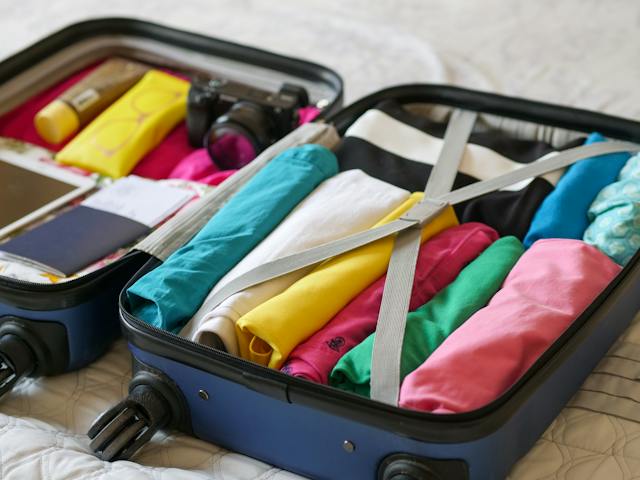
Tech and Gadgets for a Smooth Journey
Going overseas can be an exciting adventure, but it can also be stressful if you’re not prepared. One way to make your journey smoother is by bringing the right tech and gadgets. Here are some essential items to consider:
Communication Devices
Staying connected with friends and family back home is important, and having the right communication devices can make all the difference. A smartphone is a must-have, as it can be used for messaging, social media, and even navigating new places. A portable Wi-Fi hotspot can also be useful for staying connected on the go.
Photography Equipment
Capturing memories is an essential part of any trip, and having the right photography equipment can help you do just that. A high-quality camera, such as the Canon PowerShot SX500, can take stunning photos without taking up too much space in your luggage. A GoPro is also a great option for capturing action-packed moments.
Power Solutions
Keeping your devices charged is crucial, especially when you’re traveling. Make sure to bring the right chargers and power adapters for your devices, and consider investing in a portable charger for when you’re on the go. It’s also a good idea to bring a power strip so you can charge multiple devices at once.
By bringing the right tech and gadgets, you can make your overseas adventure smoother and more enjoyable. Don’t forget to pack these essential items before you go!
Essential Travel Documents and Money Management
When traveling overseas, it is crucial to ensure that all essential travel documents are in order and that money is managed properly. Here are some tips on how to manage travel documents and money:
Passport and Visas
A valid passport is the most important travel document required for overseas travel. Ensure that the passport has at least six months validity from the date of entry into the destination country. Some countries may also require a visa for entry, so it is essential to check the visa requirements and obtain the necessary visas before departure.
Travel Insurance
Travel insurance is an essential document that provides coverage for unforeseen events such as medical emergencies, trip cancellation, and lost or stolen luggage. It is highly recommended to purchase travel insurance before embarking on any overseas adventure.
Local Currency and Credit Cards
It is essential to have local currency on hand for small purchases and to pay for transportation. ATMs are widely available in most countries, but it is important to check for any fees or restrictions on international withdrawals. Credit cards are also widely accepted in most places, but it is important to inform the bank of the travel plans to avoid any issues with card usage.
In addition, it is recommended to carry a security belt to keep important documents and ID safe and secure while traveling. By following these tips, travelers can ensure a smooth and stress-free overseas adventure.
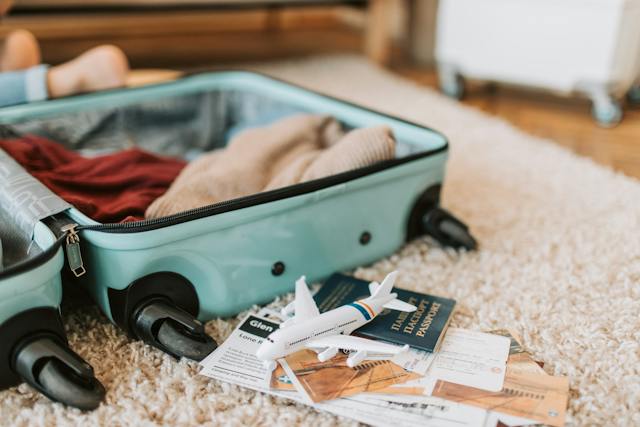
Packing the Right Clothing for Your Destination
When it comes to packing for an overseas adventure, choosing the right clothing is crucial. The right clothes can make or break your trip, so it’s important to pack smart. Here are some tips for packing the right clothing for your destination.
Layering for Various Climates
One of the most important things to consider when packing for an overseas adventure is the weather. Depending on your destination, you may encounter a wide range of temperatures and weather conditions. To prepare for this, it’s important to pack clothing that can be layered. This will allow you to adjust your clothing as needed to stay comfortable in changing weather conditions.
Choosing Versatile Footwear
Another important consideration when packing for an overseas adventure is footwear. You want to choose shoes that are comfortable and versatile enough to wear in a variety of situations. For example, if you plan to do a lot of walking, you’ll want to pack comfortable walking shoes. If you plan to go out to dinner or attend a formal event, you’ll want to pack dressier shoes. It’s also a good idea to pack shoes that can easily be dressed up or down, depending on the occasion.
Accessorizing for Function and Fashion
Finally, when packing for an overseas adventure, it’s important to think about accessories. Accessories can help you stay organized and comfortable, while also adding some style to your travel wardrobe. Some key accessories to consider include a travel wallet, a scarf or shawl for layering, a hat to protect yourself from the sun, and sunglasses to protect your eyes. You may also want to pack some jewelry or other accessories to add some flair to your outfits.
By following these tips, you can pack the right clothing for your destination, ensuring that you stay comfortable and stylish throughout your trip. Make sure to include these items on your packing list and tailor your clothing choices to your travel style and destination.
Health, Hygiene, and Miscellaneous Must-Haves
Toiletries and Personal Items
When traveling overseas, it’s important to pack the right toiletries and personal items to ensure good health and hygiene. Make sure to bring travel-sized shampoo, conditioner, body wash, and toothpaste to save space in your luggage. Don’t forget to pack a toothbrush, floss, and mouthwash to maintain good oral hygiene. Additionally, it’s important to pack sunscreen, insect repellent, and hand sanitizer to protect your skin and prevent the spread of germs.
First Aid and Medications
It’s always a good idea to bring a small first aid kit with you when traveling overseas. This should include items such as band-aids, antiseptic wipes, pain relievers, and any prescription medications you may need. Make sure to bring enough medication to last the duration of your trip, and keep them in their original prescription bottles to avoid any issues with customs.
Snacks and Entertainment
Long flights and layovers can be a drag, so it’s important to pack snacks and entertainment to keep yourself occupied. Bring non-perishable snacks such as granola bars, trail mix, or dried fruit to keep you fueled throughout your journey. Don’t forget to pack a good book, a deck of cards, or your favorite electronic device to keep you entertained during downtime.
Overall, packing the right health, hygiene, and miscellaneous must-haves is essential for any overseas adventure. By following these packing tips and bringing along essential items, you can ensure a comfortable and enjoyable trip while staying healthy and safe. And in the current COVID-19 climate, it’s more important than ever to prioritize good hygiene and follow recommended safety guidelines.
Habits That Will Improve Your Home Life
You may be someone who leads a busy lifestyle. What you don’t want to forget about is finding ways to be happier at home.
Keep in mind that you have a lot of control over your daily routine and what you choose to do or not do. There are some habits that will help improve your home life that you may want to give a try. This will give you a boost in your mood and help ensure that you enjoy living in your home.
Clean & Declutter
One habit that will improve your home life is to clean and declutter your belongings. Try to get on a regular cleaning schedule and routine. It’ll be a less overwhelming job if you break it up and do some cleaning more often. Now is a good time to take notice of what might need repairing and to see if there are any unwanted pests lurking around. Go through your closets, cupboards, and boxes and get rid of items you no longer need or use. It may also be helpful to wipe down countertops and pick up each night before bed.

Get Your Finances in Order
Being a homeowner can quickly add up and you may find you are spending more money than you want to. Now is a good time to start saving up your money for home expenses so you have access to cash when you need it fast. You may also want to look into real estate investing as a way to earn more money on the side. Here you can learn more about 12 Ways You Can Earn Money which will help put you in a better position financially. Once you start making more money you can begin to put money away in an emergency fund. It will also be useful to come up with a monthly budget that you can follow to ensure you can pay your bills on time.
Get Better Organized
You want to make sure you can find what you’re looking for in a hurry around the house. Therefore, one idea is to get better organized if you want to improve your home life. Make sure that your files are put away somewhere safe and easily accessible. You may also want to keep a family calendar that you can hang up so you know where everyone is at different times throughout the week. You’ll feel less stressed out when your home is in order and you can locate what you need in a hurry. Get better organized by going room by room and figuring out what you want to keep and donate or get rid of. You may also want to incorporate more storage solutions so that all of your belongings have a place to exist that’s out of the way.
Find Ways to Reduce Stress
The last situation you want is to feel stressed out every day at home. Therefore, you should find healthy ways to reduce and manage your stress. Improve your home life by taking time for self-care activities. You should also make it a habit to adopt a relaxing bedtime routine so you can fall asleep quicker. You may also want to make sure that you are getting outside and getting some exercise daily. Think about setting up a reading nook or meditation room at your home. This way you will have somewhere quiet to retreat to when you need a break.
Have A Morning Routine
You want to wake up each day feeling refreshed and ready to tackle your to-do list. Consider going to bed and waking up around the same time each day which will help get you on a better sleep schedule. It may also help to get into a consistent morning routine. For example, you can get out of bed and review a gratitude list to help set the right tone for the day ahead. Be sure that you make your bed and get ready for the day as well. You should also make time to eat a nourishing and nutritious breakfast that will provide you with plenty of energy. You’ll feel more ready to get busy working after you’ve taken good care of yourself right away in the morning.
Conclusion
These are some useful and practical habits that will improve your home life. This will help ensure that you feel happy at home and can avoid becoming overwhelmed and stressed out. Be patient with yourself as you adapt to a new schedule and way of living because changing habits can be challenging initially. Stick with them and it won’t be long before you notice positive changes in your life.
Why Buy An Apartment (Instead Of A House)?
Houses can have many benefits over apartments including being more spacious and offering more freedom when renovating. However, apartments do have some advantages over houses. This post lists some of the top reasons to buy an apartment instead of a house.
Greater affordability
Those who are buying a home for the first time are often better off buying an apartment than a house. This is because apartments are generally cheaper to buy, and so you don’t have to put down such a high down payment. Apartments also typically come with cheaper energy bills because they are smaller. Upper floor apartments may even require less heating because they are able to absorb much of the heat rising up from apartments below.

Easier management
Apartments can be easier to manage than houses because there’s less space to look after. Cleaning your whole home from top to bottom takes less time, and you may find that there are less repairs to keep on top of. This reduced upkeep can make apartments an attractive option for seniors and those with disabilities (ground floor apartments tend to be the best option).
Better security
You’re less likely to be burgled when living in an apartment – particularly an upper floor apartment. Many apartment buildings can only be accessed with a fob or a code. Residents meanwhile have control over which visitors they let into the building – which could include voice/video intercoms for confirming visitors’ identities. If home security is important to you, consider an apartment.
Investment opportunities
If you’re investing in UK property to let out, an apartment could be a good option. Apartments are popular choices for those renting and you could find it easier to secure tenants than you may do for a house. You also don’t have to spend as much upfront on your investment, and there’s less maintenance to worry about.
Central locations
When looking for properties in city centres and other prime locations, apartments are typically easier to find than houses. This is because apartments can be placed over shops and other commercial buildings. This can be convenient if you’re working in the city centre, and also gives you quick access to all the amenities you need. For many young people that want to be situated in the hub, apartments can be a great option for this reason.

Access to scenic views
Upper floor apartments can also come with stunning views that aren’t accessible when buying a house. Features like balconies can help you to further take advantage of these views. If you’ve always wanted to wake up to an impressive view, consider whether an apartment could be the way to access this.
Shared facilities
Some apartment buildings have their own private facilities like gyms, cafeterias and pools. These are amenities that you wouldn’t have access to when buying a house. It’s worth noting that you’ll pay extra for an apartment with these facilities, and that most apartment buildings do not have these facilities (although there may still be private shared amenities like private off-road parking). Spend your time looking for these apartments.
Best Road Trip Cars: Top 10 Vehicles for Your Next Adventure
Road trips are a classic way to travel and explore new places, and having the right car can make all the difference. Whether you’re planning a cross-country adventure or a weekend getaway, choosing the best road trip car can greatly enhance your experience. From spacious SUVs to fuel-efficient hybrids, there are plenty of options to consider when selecting a vehicle for your next road trip.
Understanding the features that make a car suitable for road trips is essential when making a decision. Comfort, space, fuel efficiency, and reliability are all important factors to consider. Additionally, features like all-wheel drive, advanced safety technology, and entertainment systems can also enhance your road trip experience. With so many options available, it’s important to do your research and determine which features are most important to you.
Key Takeaways:
- Choosing the best road trip car can greatly enhance your travel experience.
- Features like comfort, space, fuel efficiency, and reliability are important when selecting a car for a road trip.
- All-wheel drive, advanced safety technology, and entertainment systems can also enhance your road trip experience.
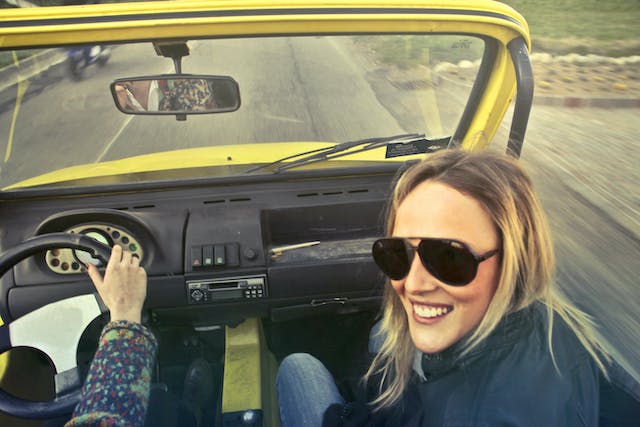
Understanding Road Trip Cars
When it comes to embarking on a road trip, choosing the right car is crucial. A comfortable and reliable vehicle can make all the difference in ensuring a smooth and enjoyable journey. Here are some key factors to consider when looking for the best road trip car.
Comfort
Comfort is a top priority for any road trip. Look for a car with spacious and supportive seats, ample legroom, and a smooth ride. A quiet cabin can also help reduce fatigue on long drives. Some cars even offer features like adjustable lumbar support, heated seats, and climate control to enhance comfort.
Storage
Storage space is another important consideration for road trips. Look for a car with a roomy trunk or cargo area, as well as flexible seating arrangements that can accommodate bulky items. Roof racks and hitch-mounted carriers can also provide additional storage options.
Fuel Efficiency
Fuel efficiency is important for both cost savings and environmental impact. Look for a car with good gas mileage, especially if you plan on driving long distances. Hybrid and electric cars can also be a great option for eco-conscious road trippers.
Reliability
Reliability is key for any car, but especially for a road trip vehicle. Look for a car with a proven track record of durability and low maintenance costs. Research manufacturer ratings and customer reviews to get an idea of a car’s reliability.
Safety
Safety should always be a top priority when choosing a car for a road trip. Look for a car with advanced safety features like lane departure warning, automatic emergency braking, and adaptive cruise control. A high safety rating from organizations like the National Highway Traffic Safety Administration (NHTSA) or the Insurance Institute for Highway Safety (IIHS) can also provide peace of mind.
Overall, finding the best road trip car requires careful consideration of factors like comfort, storage, fuel efficiency, reliability, and safety. By doing your research and test driving different options, you can find the perfect vehicle for your next adventure on the open road.
Essential Features for Road Trip Cars
When planning a road trip, choosing the right vehicle is crucial. The perfect road trip car should be comfortable, safe, reliable, and fuel-efficient. Here are some essential features to look for when selecting a road trip car:
Comfort and Space
A comfortable ride is essential for long hours on the road. Look for a car with comfortable seats, ample legroom, and headroom. Cargo space is also important, especially if you plan to bring luggage or camping equipment. Consider a car with a spacious trunk or roof rack.
Safety Measures
Safety is a top priority when it comes to road trips. Look for a car with top safety ratings, such as the Top Safety Pick+ rating from the Insurance Institute for Highway Safety (IIHS). Standard safety features such as forward collision warning and lane keep assist can also help prevent accidents.
Technology and Convenience
Road trips can be made more enjoyable with the right technology and convenience features. Look for a car with driver-assistance features such as Apple CarPlay, Android Auto, and USB ports. A digital instrument cluster can also be helpful for keeping track of important information.
Performance and Reliability
A reliable car is essential for a successful road trip. Look for a car with a good track record for reliability, such as the Toyota Prius. Performance features such as horsepower and torque can also be important, especially if you plan to drive in mountainous areas.
Fuel Efficiency
Fuel efficiency is important for both the environment and your wallet. Look for a car with good fuel economy, such as a hybrid or electric car. The Toyota Prius is a popular choice for its fuel-efficient hybrid engine.
By considering these essential features, you can select the perfect road trip car for your next adventure.

Types of Road Trip Cars
When planning a road trip, choosing the right car is crucial. There are several types of cars that are ideal for long drives, each with its own set of advantages. Here are some of the best types of road trip cars:
SUVs for Road Trips
SUVs are a popular choice for road trips due to their spacious interiors and comfortable ride. The Lincoln Navigator and Kia Telluride are two American SUVs that are great for long drives. The Toyota Highlander Hybrid is a compact SUV that offers excellent fuel efficiency and a smooth ride.
Pickup Trucks for Road Trips
Pickup trucks are another popular choice for road trips. Full-size pickups like the Ford F-150 and Chevrolet Suburban offer plenty of space for passengers and cargo. They are also great for off-road adventures. The Ford Bronco Sport is a smaller pickup truck that is perfect for those who want a more compact vehicle.
Hybrids and Electric Cars for Road Trips
Hybrids and electric cars are becoming increasingly popular for road trips. The Toyota Prius and Chrysler Pacifica Hybrid are two hybrid cars that offer excellent fuel efficiency and a comfortable ride. EVs like the Tesla Model S and Chevrolet Bolt are great for those who want to reduce their carbon footprint while on the road.
Other Notable Cars for Road Trips
The Subaru Outback and Kia Carnival are two other notable cars that are great for road trips. The Outback offers all-wheel drive and plenty of cargo space, while the Carnival is a spacious minivan that offers a comfortable ride for passengers.
Overall, there are plenty of cars that are great for road trips. It’s important to choose a car that offers comfort, space, and fuel efficiency to ensure a smooth and enjoyable journey.
Additional Considerations for Road Trips
When planning a road trip, there are many factors to consider beyond just the car itself. Here are some additional factors to keep in mind to ensure a comfortable and successful journey.
Towing Capacity and Ground Clearance
For those who plan to bring a small camper or trailer along on their road trip, it’s important to consider the car’s towing capacity. Make sure to choose a car that can safely tow the weight of your camper or trailer. Additionally, if you plan to venture off-road or explore rough terrain, a car with high ground clearance is a must.
Road Trip Routes
Choosing the right road trip route can make all the difference in the world. Consider the type of scenery you want to see, the amount of time you have, and the distance you’re willing to travel. Some popular routes include the iconic Route 66 in the United States, the Great Ocean Road in Australia, and the Garden Route in South Africa.
Road Trip Accessories
There are many accessories that can make a road trip more comfortable and convenient. A roof rack can provide extra storage space, while a portable GPS device can help you navigate unfamiliar roads. Don’t forget to pack a first aid kit, a flashlight, and a spare tire, just in case.
Road Trip Amenities
Restaurants, gas stations, and rest areas are essential amenities for any road trip. Make sure to plan your route ahead of time to ensure that you’ll have access to these necessities when you need them. Additionally, consider packing a cooler with snacks and drinks to save money and make the journey more enjoyable.
Small Campers for Road Trips
For those who want to take their road trip to the next level, a small camper can provide a comfortable and convenient place to sleep and relax. Airstream is a popular brand of small camper that is known for its stylish design and high-quality construction. Just make sure to choose a car with enough towing capacity to safely transport your camper.
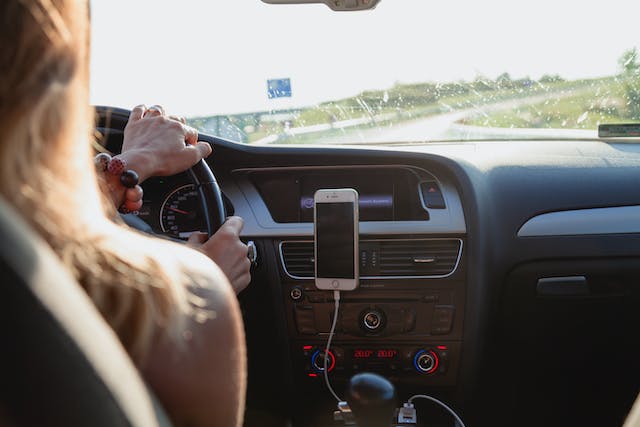
Frequently Asked Questions
What are some of the best affordable cars for long distance driving?
For those on a budget, some of the best affordable cars for long distance driving include the Honda Civic, Toyota Corolla, and Mazda3. These cars are known for their reliability, fuel efficiency, and comfort on long drives.
Which SUVs are the best for long distance driving?
SUVs that are known for their comfort and spaciousness on long drives include the Honda CR-V, Toyota RAV4, and Subaru Outback. These vehicles offer plenty of room for passengers and cargo, as well as a smooth ride.
What are some of the best used cars for road trips?
When looking for a used car for road trips, it’s important to consider factors such as reliability, comfort, and fuel efficiency. Some of the best used cars for road trips include the Honda Accord, Toyota Camry, and Subaru Legacy.
What are the best road trip vehicles for sleeping in?
For those who want to sleep in their vehicle during road trips, some of the best options include the Honda Element, Ford Transit Connect, and Chevrolet Express. These vehicles offer plenty of space for sleeping and storage, as well as comfort on long drives.
What are the top family road trip vehicles?
When traveling with a family, it’s important to have a vehicle that is spacious, comfortable, and safe. Some of the top family road trip vehicles include the Honda Odyssey, Toyota Sienna, and Chrysler Pacifica.
Which cars are recommended for long trips?
Cars that are recommended for long trips include those that are reliable, fuel efficient, and comfortable. Some of the top options include the Honda Civic, Toyota Camry, and Mazda6. These cars offer a smooth ride and plenty of features to keep passengers comfortable on long drives.



